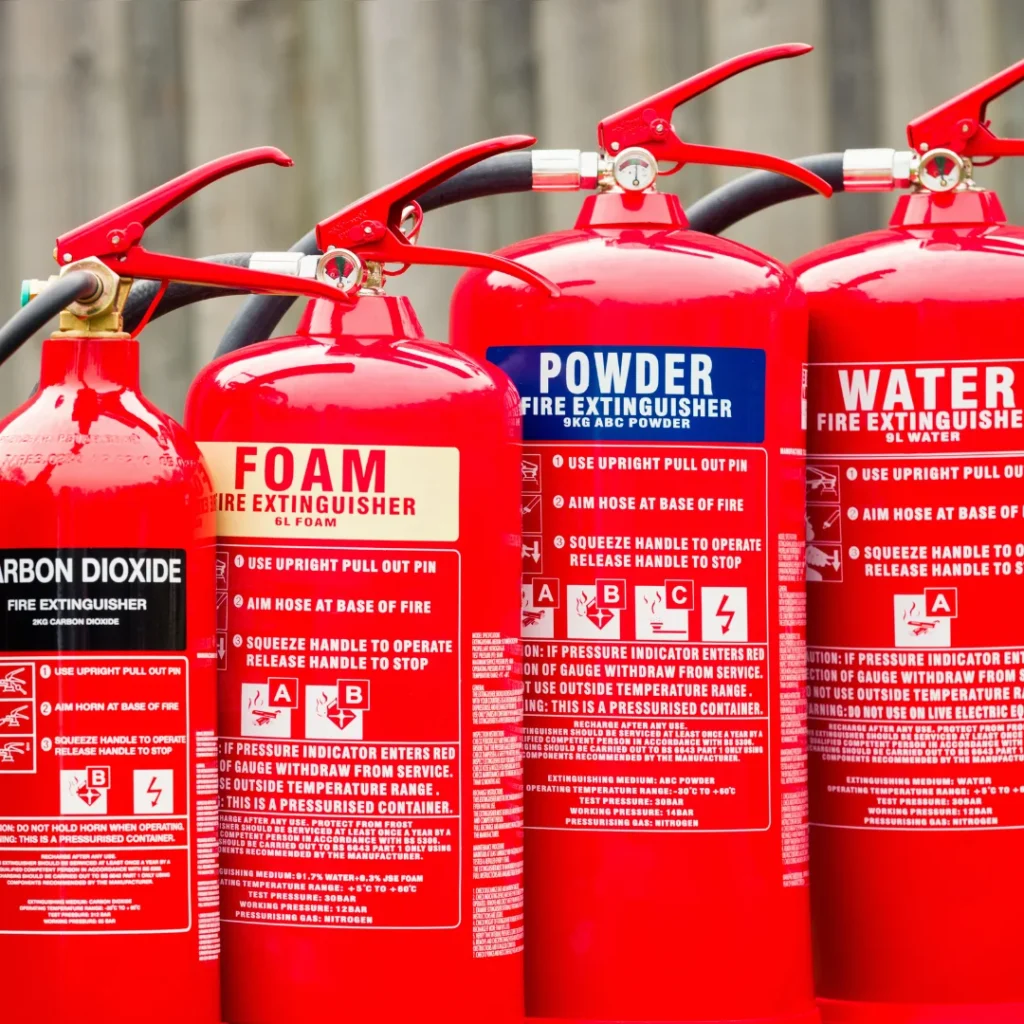Types of Fire Extinguishers
In fire protection, fire extinguishers play a crucial role. It is vital to understand what a fire extinguisher is, the different types available, and their uses, to be prepared in an emergency.
What is Fire?
Fire is a chemical oxidation reaction that releases energy in the form of heat and light. Three key elements are required to start a fire: fuel, oxygen, and a heat source. These elements make up the “fire triangle.” Without one of these components, fire cannot sustain itself.
What is a Fire Extinguisher?
A fire extinguisher is a portable device designed to fight fires in their initial stage. It works by releasing an extinguishing agent that stops the fire by interrupting the chemical reaction of the fire triangle. Using it correctly can be the difference between a controlled fire and one that becomes uncontrollable.
Types of Fire Extinguishers

Types of Fire Extinguishers
There are several types of fire extinguishers, each designed for a specific kind of fire. Below, we explain the main types of extinguishers and the types of fires they are designed to handle.
1. Water Extinguishers (Class A)
Water extinguishers are designed to put out fires involving solid materials such as wood, paper, and fabrics. This type of extinguisher works by removing the heat from the fire triangle.
2. CO2 Extinguishers (Carbon Dioxide – Class B and C)
The CO2 extinguisher is effective against fires involving flammable liquids (Class B) and electrical equipment (Class C). Carbon dioxide extinguishes the fire by displacing oxygen and cooling the affected area. This type of extinguisher is commonly found in offices, laboratories, and industrial kitchens.
3. Dry Chemical Powder Extinguishers (Class A, B, and C)
These extinguishers contain a powder that interrupts the chemical reaction of the fire. They are versatile and effective for fires involving solid materials, flammable liquids, and electrical equipment. They are the most common extinguishers found in homes and businesses.
4. Foam Extinguishers (Class A and B)
Foam extinguishers are useful for fires involving solid materials and flammable liquids. The foam forms a barrier between the oxygen and the fuel, smothering the fire.
5. Halons Extinguishers (Class A, B, and C)
Although less common due to their environmental impact, Halon extinguishers are effective for fires involving electronic equipment, as they leave no corrosive residue.
What Types of Fire Can You Face?
Fires are classified into different categories depending on the type of material that is burning. It’s crucial to identify the type of fire to use the correct extinguisher.
- Class A: Fires involving solid materials (wood, paper, fabric).
- Class B: Fires involving flammable liquids (oils, gasoline).
- Class C: Fires involving electrical equipment.
- Class D: Fires involving combustible metals.
- Class K: Fires in kitchens, such as oil and grease fires.
Factors Affecting the Price of a Fire Extinguisher
The price of fire extinguishers varies depending on the type, size, and capacity. CO2 extinguishers are typically more expensive than dry chemical extinguishers due to the complexity of the gas and the need for high-pressure containers. Prices can range between $30 and $200, depending on specifications.
Maintenance and Inspection of Fire Extinguishers
It is essential to regularly inspect fire extinguishers to ensure they function properly in case of an emergency. Safety regulations require annual inspections, and some extinguishers need to be recharged after each use or after prolonged periods.
Frequently Asked Questions
1. What are the different types of fire extinguishers?
There are several types, such as water, CO2, dry chemical powder, foam, and Halon extinguishers, each designed for specific types of fires.
2. What is a CO2 extinguisher and what is it used for?
A CO2 extinguisher uses carbon dioxide to put out Class B (flammable liquids) and Class C (electrical) fires by displacing oxygen and cooling the area.
3. How do I know which type of extinguisher to use?
It’s essential to identify the type of fire. For example, water extinguishers are used for solid material fires (Class A), while CO2 extinguishers are recommended for electrical fires (Class C).
4. What is the price of a fire extinguisher?
The price varies by type and size, ranging from $30 to $200. CO2 extinguishers are generally more expensive than dry chemical extinguishers.
5. How often should a fire extinguisher be inspected?
An annual inspection is recommended, and extinguishers should be recharged after each use or every few years, depending on the model..
